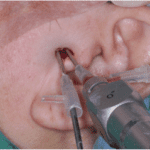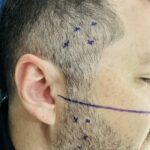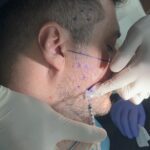TM JOINT DISORDER
TM Joint Disorder
Temporomandibular joint disorders (TMD) refer to a group of conditions affecting the jaw joint and surrounding muscles.
They can cause pain and dysfunction in the jaw, face, neck, and sometimes even lead to headaches.
Common Symptoms
- Jaw pain spreading to face and neck
- Difficulty or discomfort while chewing
- Clicking, popping, or grinding sounds in the jaw on opening and closing
- Limited jaw movement or locking of the jaw
- jaw stiffness
- Headaches or migraines
- Ear pain or ringing in the ear
Causes
- Jaw injuries or trauma
- Teeth grinding (bruxism)
- Missing teeth
- Malocclusion
- Misalignment of the jaw
- arthritis, such as rheumatoid arthritis and osteoarthritis
- Certain connective tissue diseases
- Stress and muscle tension
Diagnosis is done mostly with an MRI in an open and closed mouth view and sometimes a CT scan is also required
Treatment Options
Treatment often depends on the severity of the disorder and may include: non surgical and surgical modalities.
Non surgical
- Pain management (over-the-counter medications, muscle relaxants)
- Physical therapy or exercises
- Splint therapy
- Botox injection
- Dental rehabilitation
- orthodontic tooth alignment
- Stress management techniques
Surgical
- Non Arthroscopic lysis and lavage –
Lysis refers to the release or breaking up of adhesions or scar tissue that might have formed inside the TMJ, which can restrict joint movement or cause pain. The goal is to improve the function and mobility of the joint.
Lavage involves flushing the joint with a sterile solution (often saline or similar fluids) to remove any debris, inflammatory substances, or loose particles that could be causing pain or dysfunction. The lavage helps to clean the joint and reduce inflammation. - Arthroscopic Joint surgery (Keyhole surgery) –
In TMJ arthroscopy, a small camera (called an arthroscope) is inserted into the joint through a small incision. This allows the surgeon to visually inspect the joint and identify issues like inflammation, damage to cartilage, or any other abnormalities. If needed, the surgeon can also perform minor repairs or remove debris using small surgical instruments. And can also insert medication directly into damage tissue and muscles. Arthroscopy is preferred over open surgery for its minimally invasive nature, leading to shorter recovery times and less risk of complications. - Open joint surgery where the joint is opened with an incision in front of the ear to remove the damage disc or modify the joint anatomy
- In advance cases total joint replacement similar to Knee and Hip replacement in patients with severe arthritis and degenerative joint disease



Dr. Gagan Sabharwal is among handful of surgeons in the whole of UAE who specialize in TM Joint minimally invasive arthroscopic surgery for jaw joint disorders. If you are suffering from chronic jaw pain and have undergone non-surgical therapy with limited or no relief, you can book an appointment with him at Fakeeh University Hospital, Dubai, or at Dr. Joy Dental Clinic, Jumeirah branch, Dubai.
Dr. Gagan Sabharwal's clinic: Delhi
011-45033566
Fakeeh University Hospital, Dubai
+971-44144444
Jumeirah Clinic, Dubai
+1-80037569
